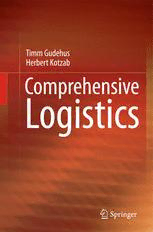
Comprehensive Logistics PDF
Preview Comprehensive Logistics
Comprehensive Logistics · Timm Gudehus Herbert Kotzab Comprehensive Logistics 123 Dr.rer.nat.Dr.Ing.habil.TimmGudehus Prof.Dr.HerbertKotzab Strandweg54 BusinessSchoolCopenhagen 22587Hamburg Dept.OperationsManagement Germany SolbjergPlads3 www.TimmGudehus.de 2000Frederiksberg Denmark [email protected] ISBN978-3-540-30722-8 e-ISBN978-3-540-68652-1 DOI10.1007/978-3-540-68652-1 SpringerDordrechtHeidelbergLondonNewYork LibraryofCongressControlNumber:2008940418 (cid:2)c Springer-VerlagBerlinHeidelberg2009 Thisworkissubjecttocopyright.Allrightsarereserved,whetherthewholeorpartofthematerialis concerned,specificallytherightsoftranslation,reprinting,reuseofillustrations,recitation,broadcasting, reproductiononmicrofilmorinanyotherway,andstorageindatabanks.Duplicationofthispublication orpartsthereofispermittedonlyundertheprovisionsoftheGermanCopyrightLawofSeptember9, 1965,initscurrentversion,andpermissionforusemustalwaysbeobtainedfromSpringer.Violations areliabletoprosecutionundertheGermanCopyrightLaw. Theuseofgeneraldescriptivenames,registerednames,trademarks,etc.inthispublicationdoesnot imply,evenintheabsenceofaspecificstatement,thatsuchnamesareexemptfromtherelevantprotective lawsandregulationsandthereforefreeforgeneraluse. Coverdesign:eStudioCalamarS.L. Printedonacid-freepaper SpringerispartofSpringerScience+BusinessMedia(www.springer.com) Preface This book presents the scope, variety and importance of modern logistics. It deals with all relevant aspects: space and time; systems, structures and processes; networksandsupplychains;economicsandtechnology;micrologisticsandmacro- logistics; intralogistics and extralogistics; planning, scheduling and control; man- agement, organization and operation. The tasks and goals of modern logistics and the options for actions are thoroughly investigated and explained. Current logistic trends and fashions are critically discussed. Strategies and methods for planning, scheduling and operating logistic networks and systems are developed. The book containsrules,algorithmsandformulasforsolvingactualproblems.Theirapplica- tionisdemonstratedbyexamplesfrombusinesspractice. The work is based on the well-known German reference-book “Logistik” by TimmGudehus,whichwaspublishedinseveraleditions(Gudehus1999/2000/2003/ 2005/2007/2010).AftertranslationbyHerbertKotzab,thecontentwasthoroughly revisedfortheinternationaleditionbybothauthors.Wehavereformulatedandsup- plementedthewholetextandupdatedfiguresandtables. The most difficult task when writing the international edition turned out to be finding the right terminology for the multitude of logistic subjects. As logistics is arelativelyyoungdiscipline,inEnglishandAmerican,evenmorethaninGerman, thereareseveralexpressionswithsimilarmeanings,forexample,inventory,stock, store, storage and warehouse. To avoid misunderstandings, we selected the most common expressions, defined the terms as precisely as necessary and used them consistently.Thetermscanbefoundviatheindex,whichmakesthisbookaswella dictionaryofmodernlogistics. Throughouttheyears,manyclientsandcolleagues,scientists,students,readers, consultants, managers and other people have contributed to this book. We thank themallforlistening,fruitfuldiscussions,criticalremarksandconstructivepropos- als.OursinceregratitudegoestoHiteshK.GadhiainCopenhagenforproofreading andmanyhelpfulcomments.WeexpressourthankstotheKu¨hneSchoolofLogistics and Management in Hamburg for transferring figures and tables into English, and toMiebachConsultinginFrankfurtforrevisingcostfiguresandtechnicaldata. v vi Preface Mostofall,wewouldliketothankourwives.Withouttheirpatienceandunder- standingthisbookwouldnotexist. June,2009 TimmGudehus Hamburg HerbertKotzab Copenhagen Contents PartI Principles,StrategiesandOrganization 1 TasksandAspectsofModernLogistics ........................... 3 1.1 SystemsandNetworks .................................... 5 1.2 TasksandObjectivesofLogistics ........................... 6 1.3 StructuresandProcesses................................... 7 1.4 ElementaryandCompoundedPerformanceStations............ 10 1.5 StructuresofLogisticNetworks............................. 15 1.6 FunctionsofLogisticCenters .............................. 19 1.7 ProcessChainsandLogisticChains ......................... 22 1.8 EffectsofLogisticCenters................................. 24 1.9 NetworkManagement..................................... 29 1.10 TaskofLogisticians ...................................... 32 2 Organization,SchedulingandControl............................ 39 2.1 Orders.................................................. 40 2.2 OrderManagementandLogisticScheduling .................. 41 2.3 ProcessOrganizationandStructureOrganization .............. 43 2.4 OrganizationPrinciples.................................... 45 2.5 SoftwareLevelsandComputerConfiguration ................. 47 2.6 DataFlowandInformationFlow............................ 48 2.7 PotentialsofInformationTechnologyforLogistics............. 50 2.8 RisksofInformationTechnologyinLogistics ................. 51 2.9 OrganizationofCompanyLogistics ......................... 53 2.10 OrganizationofScheduling ................................ 55 3 ProjectPlanningandRealization ................................ 59 3.1 PossibilitiesofAction..................................... 59 3.2 PlanningPhases.......................................... 62 3.3 RealizationSteps......................................... 64 3.4 LogisticObjectives ....................................... 65 3.5 FrameConditions ........................................ 69 vii viii Contents 3.6 PerformanceRequirements ................................ 71 3.7 DeterminationofPlanningData ............................ 73 3.8 PresentationofSystemsandProcesses....................... 75 3.9 SelectionoftheBestSolution .............................. 78 3.10 PlanningandOptimizationTools............................ 83 3.11 TechniqueandLogistics ................................... 85 4 PotentialAnalysis .............................................. 89 4.1 RequirementAnalysis..................................... 90 4.2 PerformanceAnalysis..................................... 91 4.3 ProcessAnalysis ......................................... 93 4.4 StructureAnalysis........................................ 96 4.5 Benchmarking ........................................... 97 5 StrategiesofLogistics...........................................101 5.1 TargetFunctionsandTargetFigures .........................102 5.2 Clustering,Sequencing,Securing ...........................105 5.3 SystemStrategies.........................................110 5.4 MethodsofSolutionandOptimization.......................111 5.5 SolutionandOptimizationProcedure ........................113 5.6 SegmentationandClassification ............................116 5.7 SpecializationandUniversality .............................118 5.8 ABC-Analysis ...........................................119 5.9 LogisticArticleClassifications .............................123 6 LogisticCostsandControlling...................................129 6.1 CostAccountingandPerformanceCosting ...................130 6.2 LogisticCostCalculation ..................................132 6.3 ComponentsofLogisticCosts..............................133 6.4 DepreciationandInterest ..................................137 6.5 PerformanceUnitsandPerformanceFlows ...................141 6.6 CostCentersandCostDrivers ..............................144 6.7 PerformanceCostRates ...................................146 6.8 FixedCostsDilemmaandUtilizationRisk....................149 6.9 OptionsforReducingLogisticCosts.........................151 7 LogisticPricingandMarketing ..................................157 7.1 PricingPrinciples ........................................158 7.2 PerformanceCostsandPrices ..............................159 7.3 ObjectivesofRemunerationSchemes........................162 7.4 StandardRemunerationScheme ............................162 7.5 ProjectSpecificRemunerationSchemes......................165 7.6 LogisticTariffsandDiscounts ..............................169 7.7 MarketingandPricingStrategies............................170 7.8 EconomicsandLogistics ..................................181 Contents ix 8 TimeManagement .............................................185 8.1 TimePointsandTimeSpans ...............................185 8.2 OperatingTimeandWorkingTime..........................189 8.3 Adaptation,SynchronizationandFlexibility ..................191 8.4 OrderLeadTimeofSingleStations .........................193 8.5 LeadTimesofPerformanceChains..........................195 8.6 MaterialLeadTime.......................................198 8.7 TimeSchedulingofSingleStations..........................199 8.8 TimeSchedulingofPerformanceChains .....................201 8.9 Just-in-Time.............................................207 8.10 StrategiesforLeadTimeReduction .........................208 8.11 EconomicOrderLeadTime................................209 9 RandomProcessesandDynamicForecasting......................213 9.1 RandomProcessesandStochasticFlows .....................214 9.2 ProbabilityDensitiesandTimeDistributions..................217 9.3 FrequencyDistributionsofDiscreteValues ...................221 9.4 MeanValuesandVariancesinLogistics......................223 9.5 MathematicalForecasting..................................229 9.6 DemandPlanningandForecasting ..........................234 9.7 TestFunctionsandScenarioCalculations.....................238 9.8 DynamicForecasting .....................................242 9.9 DemandForecastinginLogisticNetworks....................244 10 OrderSchedulingandOperatingStrategies .......................247 10.1 PerformanceandProductionStructures ......................248 10.2 ProcessingStrategies......................................253 10.3 AllocationStrategies......................................256 10.4 SequencingStrategies.....................................257 10.5 OrderProductionandStockProduction ......................259 10.6 DynamicScheduling......................................269 11 InventoryManagement .........................................271 11.1 FunctionsofStocks.......................................272 11.2 CriteriaforStorekeeping ..................................276 11.3 SchedulingofStorageChainsandNetworks ..................279 11.4 SchedulingParameters ....................................282 11.5 StorekeepingParameters...................................284 11.6 CostRatesforReplenishmentandStoring....................287 11.7 StorekeepingCosts .......................................290 11.8 StockAvailabilityandSafetyStock .........................295 11.9 DemandDependencyofStockandStorekeepingCosts .........306 11.10 CentralizationofStocks ...................................308 11.11 ReplenishmentStrategies ..................................311 11.12 Cost-OpportunityofStorekeeping...........................317 x Contents 11.13 DynamicInventoryScheduling .............................321 11.14 InventoryOptimization....................................325 12 LogisticUnitsandMasterData ..................................329 12.1 FunctionsofLoadUnits ...................................330 12.2 FillingUnitsandFillingOrders.............................332 12.3 LoadUnitsandLoadCarriers ..............................335 12.4 PackingStrategies ........................................342 12.5 FillingStrategiesandLoadUnitDemand.....................351 12.6 LogisticMasterData......................................357 12.7 ElectronicKanban........................................362 13 LimitPerformancesandQueuingEffects .........................365 13.1 ThroughputandPerformanceRates .........................365 13.2 LimitPerformancesofElementaryStations...................366 13.3 OperatingStrategies ......................................383 13.4 LimitPerformanceLaws ..................................388 13.5 WaitingQueuesandQueuingLaws..........................395 13.6 ReliabilityandAvailability.................................408 13.7 CapabilityAnalysis.......................................419 13.8 AcceptanceofPlantsandSystems...........................423 14 Purchasing,SalesandLogistics ..................................427 14.1 CoreCompetenciesofSalesandMarketing...................428 14.2 CoreCompetenciesofPurchasing...........................429 14.3 OrderSchedulingandSupplyManagement...................429 14.4 Products,MerchandizeandServices.........................430 14.5 DeliveryServiceandLogisticQuality .......................432 14.6 SalesChannelsandDistributionStructure ....................432 14.7 PriceCalculationandLogisticCosts.........................433 14.8 InternalLogisticServices..................................433 PartII Systems,NetworksandOperations 15 LogisticNetworksandSystems ..................................439 15.1 DynamicNetworks .......................................440 15.2 HierarchyofLogisticSystems..............................441 15.3 SystemPlanningandSystemOptimization ...................443 16 StorageSystems................................................449 16.1 StorageRequirements.....................................450 16.2 StoreplacesandStorageTypes..............................456 16.3 StorageTechnique........................................468 16.4 StorageStrategies ........................................480
